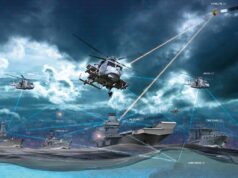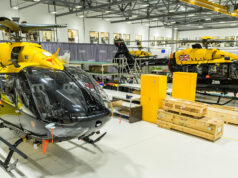The A400M partner nations have agreed an arrangement with Airbus that is designed to sort out issues over cost and capability.
Key areas to be ‘rebaselined’ include the introduction of new capabilities, the delivery schedule, refit of the aircraft and financial terms.
The notice published by the MoD reads:
“This establishes an overall agreement regarding the roadmap to achieve the A400M’s full suite of contracted capabilities, aircraft deliveries and retrofit schedule while also keeping the programme on a sound financial footing. The re-baselining agreement has been the subject of intensive negotiations between the partner nations and Airbus for more than a year and provides solid foundations for the A400M in the decades ahead, for existing and future export customers.”
“The overall aim of the Global Rebaselining – both for Airbus as well as for OCCAR and the Launch Customer Nations – was to recover a sustainable contractual basis for and to ensure a proper execution of the A400M programme,” said Dirk Hoke, Chief Executive Officer of Airbus Defence and Space.
“I would like to thank our customers for their engagement and support during the discussions over the last two years. This new situation will also support our efforts to export the A400M worldwide.”
According to Airbus, the Launch Customer Nations have agreed on the following:
1. New capabilities development plan
Based on this new plan, Airbus aims to provide all agreed capabilities over an adjusted timeframe and to give solid visibility to the Launch Customer Nations for a better planning of operations and engagements. First elements of this new planning have already been implemented with deliveries of tactical capabilities which enable the Launch Customer Nations to operate in various mission profiles all around the world.
2. New production delivery schedule
All parties have agreed to stretch the A400M production plan while keeping the programme’s contractual timeframe until 2030. The new production delivery schedule both addresses the Launch Customer Nations’ expectations and significantly reduces the financial exposure. Furthermore, the new delivery schedule enables the A400M programme to adjust the production rate in order to accommodate export orders in the coming years.
3. New retrofit delivery schedule
The new retrofit agreement with the Launch Customer Nations will implement the final contractual standard with associated capabilities to all of the delivered A400M aircraft.
This new agreement will minimise aircraft downtimes to meet customer expectations while optimising the retrofit process for Airbus.
4. New financial terms
Airbus, OCCAR and the Launch Customer Nations have agreed on the implementation of a revised financial retention mechanism. This new scheme recognises the achievement of A400M capabilities which have already been implemented in service while keeping an incentive to finalise the development of the ultimate contractual standard.
Furthermore, a significant compensation in products and services has been agreed in exchange of accrued financial obligations due to past late deliveries. This provides both the customers and industry with an opportunity to jointly enhance the A400M platform, say the firm.













Anyone know the actual state of play with RAF A400s. What can’t they do that the specification said they could do?
I heard/saw that most were grounded somewhere anyway at the moment. They can’t parachute out of the doors was it? Have to use the ramp? That rings a bell.
I do remember reading about paradrop issue Steve just mentioned. That is the reason the french ordered some c130j for tactical ops.
Helicopter refueling is still not resolved afaik. The engines were creating too much turbulence. They talked about a longer refuel line, but that would need to be thinner. Not sure on the progress.
Also there was a weight issue due to EU regulations for passenger seat safety, which make the seats heavier
Biggest problem is that the business case was done when the 1 Euro = 0.92 USD, now the Euro is much stronger and makes the A400 cost almost as much as a c17 globemaster, when they intended to be closer to c130 in terms of price.
I have no experience with jumping out of aircraft but wouldn’t jumping out the back be easier than jumping out the side?
It seems easier when I try and imagine it in my head anyway.
Seems like an odd reason to ground them as that’s not all they do.
Safety and you can get more blokes out of the 2 doors than the ramp in a jump window I believe.
I haven’t heard that they were grounded. France is using them throughout the Sahel
I don’t parachute either, so can’t comment on why it is a problem, enough for some countries to purchase additional c130j. I imagine it will be resolved at some point, but i guess not quickly enough for some who have urgent needs
This program has been poorly managed with delays and cost overruns. I guess it’s not so bad when you look at f35 😉
The saving grace for the A400 is that c17 production is ending and that it can carry modern IFV (boxer, etc…)which the c130 cannot
I can’t remember where I saw it but it was something like 15 out of 20 aren’t flying at the moment.
Let’s not forget you can do things in this aeroplane you wouldn’t dream doing in a C17. Bottom line is C17 is an excellent strategic transport that is sometimes required to do a bit of tactical work. A400M is a tactical transport that can easily step up to do many strategic tasks when required. But the two don’t compete. They’re complementary.
Para doors are used as it’s easier and quicker to get 88 blokes out the door in sim sticks, with a ton of equipment strapped to them, using a static line low level parachute. Tailgating is generally used for free fall and role specific parachuting, example with a RIB and a dozen blokes into the sea etc.
Jumping out of a perfectly good aircraft is a sure sign of being insane, or a paratrooper. Sorry for the redundancy. 🙂
French ordered 4 C130J for refuelling their Caracal CSAR helicopters. TP400 engine had problems initially with its power gear boxes but this issue now resolved.
Fleet not grounded. 58 paras can quite happily jump out of one side door in a single pass. Problem is getting 116 out both doors simultaneously. The risk of two jumpers coming together behind the aeroplane deemed too high. Problem is aircraft wake too symmetrical due to handed prop rotation. C130 all props turn in same direction and wake is asymmetrical. C17 had similar problem. Took them some time to resolve. Airbus is resolving by redesigning side door deflectors. Can’t refuel helos cause in the event of emergency break away, rotor tips too close to high T tale. Hose has to be longer. Cobham designing new hose/drum unit. Everything else is more or less there. Biggest problem is getting sophisticated IT systems associated with aircraft maintenance to work as intended. Too many manual/paper based workarounds still in operation. Slowly getting on top of that. What is often not mentioned is that aircraft exceeds requirements in most other areas. Biggest headache is for Airbus however, who grossly miscalculated complexity and cost of developing this fantastic machine.
Interesting. Thank you.
I agree, very informative. I had heard that low level terrain following was not possible in the early aircraft. I assume from your post that this has been corrected or was erroneous to start with?
I do jump out of planes and in 2 door operations I wouldn’t be happy going out of the door into non disturbed air flow, recipe for collision behind the aircraft, even with improved deflectors surely they will have to do staggered exits. Are they still planning on 2door + ramp for confined DZ drops.
Problem being single sticks will mean a longer run in or two passes over the DZ. Deflectors will work to an extent, like they do on the C17, as jumped that a few times in the states, and although those deflectors are primarily for the reduction of slipstream on exiting the airframe, due to its higher speed. JATEU are still having a go at cracking the issue, but in reality if it came to a big drop, the powers that be would more than likely see a mid air collision or twists from a few blokes as a risk worth taking to get the lead task force on the deck. If we are honest no matter what the PJIs do the blokes sim sticks timing never last past the 3rd or 4th bloke anyway lol
Impossible to control and guarantee staggered jumping with large sticks. Airbus conducted endless wind tunnel testing with various deflector designs and think they’ve found solution. But no way to completely eliminate risk, even in asymmetric or disturbed airstream. Collisions occur from time to time even with C130. More so with C17 (but yanks just accept higher risk levels) and will always be present even with modified A400M, but down to a level RAF will be prepared to release to service.
In the last month I have been working at zaragoza Spain and bricy France with the a400m and all are operational. Aar is tricky but doable